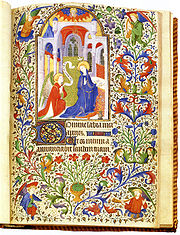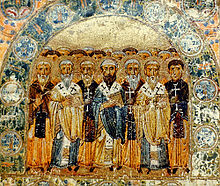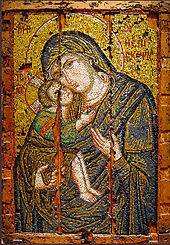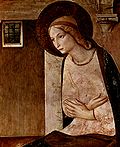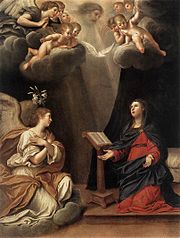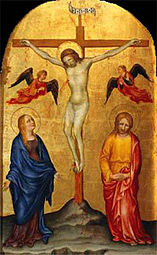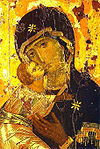box: view · Martin Luther believed that Mary did not have other children and did not have any marital relations with Joseph . The Latin text of the 1537 Smalcald Articles written by Martin Luther used the term "Ever Virgin " to refer to Mary .[ 63 ] The perpetual virginity of Mary was Luther 's lifelong belief , even after he rejected other Marian doctrines .[ 63 ] [ 66 ] [ 67 ]
Huldrych Zwingli directly supported perpetual virginity and wrote: "I firmly believe that [Mary ], ... forever remained a pure , intact Virgin ."[ 68 ] Like Zwingli , the English reformers also supported the concept of perpetual virginity , but often varied on their reasons for the support .[ 64 ] Luther and Zwingli 's support of perpetual virginity was endorsed by Heinrich Bullinger and was included in the 1566 Second Helvetic Confession .[ 69 ]
John Calvin was less emphatic in his open support of the idea , and neither flatly accepted or rejected it .[ 64 ] He cautioned against the idea of "impious speculation " on the topic of perpetual virginity .[ 69 ] However , Calvin rejected arguments against Mary 's perpetual virginity based on the mention in Scripture of brothers of Jesus that were interpreted to imply that Mary had other children .[ 70 ]
The Anglican reformers of the 16th and 17th century supported perpetual virginity "on the basis of ancient Christian authority ".[ 63 ] In the 18th century , John Wesley one of the founders of Methodism also supported the doctrine and wrote that: "... born of the blessed Virgin Mary , who , as well after as before she brought Him forth , continued a pure and unspotted virgin ."[ 63 ] [ 71 ] [ 72 ]
Later Protestant teachings
Many current Protestant churches teach the virgin birth of Jesus without teaching that Mary remained a virgin for the rest of her life .[ 8 ] [ 9 ]
Diarmaid MacCulloch a historian of the Reformation , wrote that the reason why the early reformers upheld Mary ’s perpetual virginity was that she was "the guarantee of the Incarnation of Christ ", a teaching that was being denied by the same radicals that were denying Mary ’s perpetual virginity .[ 73 ] However , the absence of clear Biblical statements expressing the doctrine , in combination with the principle of sola scriptura kept references to the doctrine out of the Reformation creeds and , together with the tendency to associate veneration of Mary with idolatry [ 74 ] and the rejection of clerical celibacy [ 75 ] led to the eventual denial of this doctrine among Protestants , who , thus uncommitted to a doctrine the perpetual virginity , take the "brothers " (ἀδελφοί ) οf Jesus mentioned in the New Testament most naturally (but not certainly ) to be children of Mary and thus Jesus ' half brothers , rather than his cousins or stepbrothers from a postulated previous marriage of Joseph .[ 76 ]
However , some conservative Lutheran scholar such as Franz Pieper (1852 –1931 ) refused to follow the tendency among Protestants to insist that Mary and Joseph had marital relations and children after the birth of Jesus . It is implicit in his Christian Dogmatics that belief in Mary 's perpetual virginity is the older and traditional view among Lutherans .[ 77 ] He stated , that "we should simply hold that (Mary ) remained a virgin after the birth of Christ because Scripture does not state or indicate that she later lost her virginity ".[ 78 ] He taught that "Christ , our Saviour , was the real and natural fruit of Mary 's virginal womb . . . This was without the cooperation of a man , and she remained a virgin after that "; and that " Christ . . . was the only Son of Mary , and the Virgin Mary bore no children besides Him . . . I am inclined to agree with those who declare that 'brothers ' really mean 'cousins ' here , for Holy Writ and the Jews always call cousins brothers ".[ 79 ]
Scripture
Some passages in the New Testament have been used to voice objections to the doctrine of perpetual virginity , while other passages have been used to support it .
One objection concerns the mention of brothers and sisters of Jesus ,[ 80 ] who include James Joses the form in Mark 6:3 but "Joseph " in Matthew 13:55 Simon , and Jude They have been interpreted as children of Joseph and Mary , a view put forward by Tertullian and perhaps by Hegesippus but that , when proposed by Helvidius met with opposition from Jerome who was apparently voicing the general Christian opinion at the time .[ 81 ] Jerome held that the "brethren " in question were children of Mary , the mother of James and Joses , named in Mark 15:40 and 15:47 a sister of Jesus ' mother (John 19:25 [ 81 ] [ 82 ] making them cousins of Jesus .
Another view , expressed by Eusebius and Epiphanius is that they were children of Joseph by an earlier marriage .[ 81 ] A modern view is that they were children of Cleopas , a brother of Joseph according to Hegesippus , and of "Mary the mother of James and Joses " seen as sister -in -law , not blood sister of Mary , the mother of Jesus .[ 81 ] The 1978 book Mary in the New Testament: A Collaborative Assessment by Protestant and Roman Catholic Scholars [ 83 ] concluded that "it cannot be said that the New Testament identifies them (the "brothers and sisters " of Jesus ) without doubt as blood brothers and sisters and hence as children of Mary ".[ 84 ]
Matthew 1:25 states that Joseph had no marital relations with Mary "until " (ἕως οὗ ) she had borne Jesus . Writers such as R .V . Tasker [ 85 ] and D . Hill [ 86 ] argue that this implies that Mary and Joseph had customary marital relations after the birth of Jesus . Others , such as K . Beyer , point out that Greek ἕως οὗ after a negative "often has no implication at all about what happened after the limit of the 'until ' was reached ",[ 87 ] and Raymond E . Brown observes that "the immediate context favors a lack of future implication here , for Matthew is concerned only with stressing Mary 's virginity before the child 's birth ".[ 87 ]
On the other hand , Mary 's response to the angel , when told that she will conceive , "How will this be , since I am a virgin ?", has been interpreted , at least since the time of Gregory of Nyssa as indicating that Mary had taken a lifelong vow of virginity , even in marriage:
For if Joseph had taken her to be his wife , for the purpose of having children , why would she have wondered at the announcement of maternity , since she herself would have accepted becoming a mother according to the law of nature ?[ 88 ]
This interpretation , although upheld by many , is rejected by writers such as Howard Marshall .[ 89 ] and is considered implausible by Raymond E . Brown .[ 90 ]
A passage used to support the doctrine of perpetual virginity is of the sayings of Jesus on the cross i .e . the pair of commands first to his mother "Woman , behold your son !" and then to his disciple "Behold , thy mother !" in John 19:26 -27 [ 49 ] [ 50 ] [ 91 ] The Gospel of John then states that "from that hour the disciple took her unto his own home ". Since the time of the Church Fathers this statement has been used to reason that after the death of Jesus there was no one else in the immediate family to look after Mary , and she had to be entrusted to the disciple given that she had no other children .[ 49 ] [ 50 ] [ 91 ] This passage was one of the arguments Pope John Paul II presented in support of perpetual virginity .[ 50 ] [ 92 ] [ 93 ] John Paul II also reasoned that the command "Behold your son !" was not simply the entrustment of Mary to the disciple , but also the entrustment of the disciple to Mary in order to fill the maternal gap left by the death of her only son on the cross .[ 94 ] [ 95 ]
Islamic perspective
In Sura 19 ,[ 96 ] the Qur 'an declares that Jesus was the result of a virgin conception (verses 20 -22 ), and some extend this to mean perpetual virginity of Mary .[ 97 ] [ 98 ] There is no clear doctrinal belief one way or another as to whether she retained her virginity after Jesus ' birth .[ 99 ] [ 100 ]
In Islam Jesus and Mary were the only two children not be touched by Satan at the moment of their birth , for God placed a veil between them and Satan .[ 101 ] The Qur 'an says that Jesus was the result of a virgin birth . The account of the annunciation and birth of Jesus is provided in Sura 3 and 19 of The Qur 'an , where an angel is sent to announce that Mary should expect to bear a son , despite being a virgin .[ 102 ]
See also
References
^ What Every Catholic Should Know about Mary by Terrence J . McNally 2009 ISBN 1441510516 page 168 [1 ] ^ a b c The Blackwell Companion to Catholicism by James Buckley , Frederick Christian Bauerschmidt , Trent Pomplun 2010 ISBN 1444337327 page 315
^ a b The International Standard Bible Encyclopedia by Geoffrey W . Bromiley 1995 ISBN 0802837859 page 271
^ a b c d e f Mary in the New Testament edited by Raymond Edward Brown 1978 ISBN 0809121689 pages 278 -281
^ a b c Merriam -Webster 's encyclopedia of world religions by Merriam -Webster , Inc . 1999 ISBN 0877790442 page 1134
^ Catechism of the Catholic Church §499 ^ Divine Liturgy of St John Chrysostom Coptic Liturgy of St Basil Liturgy of St Cyril Liturgy of St James Understanding the Orthodox Liturgy etc .^ a b c What Every Catholic Should Know about Mary by Terrence J . McNally 2009 ISBN 1441510516 page 170
^ a b c Christian confessions: a historical introduction by Ted Campbell , 1996 ISBN 0664256503 page 47
^ Jackson , Gregory Lee , Catholic , Lutheran , Protestant: a doctrinal comparison 1993 ISBN 9780615166353 page 254 ^ Bäumer , Remigius . Marienlexikon Gesamtausgabe . Leo Scheffczyk , ed . Regensburg: Institutum Marianum , 1994 . ISBN 3 -88096 -891 -8 p . 190 . In particular , it was the lifelong belief of Luther himself (Luther 's Works The American Edition . Jaroslav J . Pelikan & Helmut Lehmann , eds . 55 vols . St . Louis & Philadelphia: CPH & Fortress Press , 1955 -1986 . Vol . 22 , pp . 214 -215 ).^ B . Townsend Waddill III , "The Perpetual Virginity of Mary ".Founding figures of Anglicanism such as Hugh Latimer and Thomas Cranmer followed the tradition that they had inherited by accepting Mary as 'ever virgin '" (http: //www .anglicancommunion .org /ministry /ecumenical /dialogues /catholic /arcic /docs /pdf /mary _commentary _Tim _Bradshaw .pdf Timothy Bradshaw , "Commentary and Study Guide on the Seattle Statement Mary: Hope and Grace in Christ of the Anglican – Roman Catholic International Commission ").]^ a b Mark Miravalle , 1993 , Introduction to Mary Queenship Publishing ISBN 978 -1 -882972 -06 -7 pages 56 -64
^ a b c Mary in the New Testament edited by Raymond Edward Brown 1978 ISBN 0 -8091 -2168 -9 page 273
^ A history of the church in the Middle Ages by F . Donald Logan , 2002 , ISBN 0415132894 p150 ^ Joseph , Mary , Jesus by Lucien Deiss , Madeleine Beaumont 1996 ISBN 0814622550 page 30 ^ The image of the Virgin Mary in the Akathistos hymn by Leena Mari Peltomaa 2001 ISBN 9004120882 page 127 ^ Catechism of the Catholic Church by the Vatican , 2002 ISBN 0860123243 page 112 ^ Vatican website : Catechism item 499 ^ Vatican website: Lumen Gentium item 57 ^ Eastern Orthodoxy through Western eyes by Donald Fairbairn 2002 ISBN 0664224970 page 100 ^ Annunciation Art , Phaidon Press , 2004 , ISBN 0 -7148 -4447 -0 ^ The Annunciation to Mary by Eugene Laverdiere 2007 ISBN 1568545576 page 29 ^ Encyclopedia of Comparative Iconography by Helene E . Roberts 1998 ISBN 1579580092 page 904 ^ Treasures from the Ark: 1700 Years of Armenian Christian Art by Vrej Nersessian 2001 ISBN 0712346996 page 167 ^ Heroes of the icon: people , places , events by Steven Bigham 1998 ISBN 1879038919 page 47 ^ The icon handbook by David Coomler 1995 ISBN 0872432106 page 203 ^ a b The Theme of Mary 's Virginity ", in Mary in the New Testament edited by Raymond Edward Brown 1978 ISBN 0809121689 pages 267 -277
^ a b c d e f Encyclopedia of theology: a concise Sacramentum mundi by Karl Rahner 2004 ISBN 0860120066 pages 896 -897
^ L . Gambero , Mary and the Fathers of the Church trans . T . Buffer (San Francisco: Ignatius , 1991 ), p . 35 .^ L . Gambero , Mary and the Fathers of the Church trans . T . Buffer (San Francisco: Ignatius , 1991 ), p . 40 .^ Quasten , Patrology 1:120 -1 .^ Matthew 13:56 and Mark 6:3 ^ Protoevangelium chapters 7 –8 .^ Saint Joseph: His Life and His Role in the Church Today by Louise Bourassa Perrotta 2000 ISBN 0879735732 page 86 ^ Josephus , Antiquities book 20 , chapter 9 ^ The Westminster handbook to Origen by John Anthony McGuckin 2004 ISBN 0664224725 page 150 ^ L . Gambero , Mary and the Fathers of the Church trans . T . Buffer (San Francisco: Ignatius , 1991 ) pp . 97 -98 ; and also for an overview of each source .^ a b This Is the Faith by Francis J . Ripley 1973 ISBN 0852446780 page 264
^ Athanasius , Orations against the Arians 2 .70 ^ Epiphanius of Salamis , The Man Well -Anchored 120 , c .f . Medicine Chest Against All Heresies 78:6 ^ Hilary of Poitiers , Commentary on Matthew 1:4 ^ Didymus the Blind , The Trinity 3:4 ^ Ambrose of Milan , Letters 63:111 ^ Jerome , Against Helvetius 21 ^ Denziger §91 ^ Mary for evangelicals: toward an understanding of the mother of our Lord by Tim S . Perry , William J . Abraham 2006 ISBN 083082569Xpages 153 -154 ^ John 11 -21 by Joel C . Elowsky 2007 ISBN 0830810994 page 318 ^ a b c Burke , Raymond L .; et al . (2008 ). Mariology: A Guide for Priests , Deacons , Seminarians , and Consecrated Persons ISBN 9781579183554 pages 308 -309
^ a b c d Mark Miravalle , 1993 , I ntroduction to Mary Queenship Publishing ISBN 978 -1 -882972 -06 -7 pages 62 -63
^ Augustine through the ages: an encyclopedia by John C . Cavadini 1999 ISBN 080283843X page 544 ^ St . Augustine , Faith , Hope & Charity By J . Kuasten , Saint Augustine (Bishop of Hippo .) 1978 ISBN 0809100452 page 126 ^ Protoevangelium of James 4 , 7 , 8 -9 , 15 ^ The History of Theology: Middle Ages by Giulio D 'Onofrio , Basil Studer 2008 ISBN 0814659160 page 38 ^ Aquinas on doctrine: a critical introduction by Thomas Gerard Weinandy , John Yocum 2004 ISBN 0567084116 page 95 ^ The Westminster handbook to Thomas Aquinas by Joseph Peter Wawrykow 2005 ISBN 0664224695 page 91 ^ What Every Catholic Should Know about Mary by Terrence J . McNally 2009 ISBN 1441510516 page 185 ^ An exposition of the epistle of Saint Paul to the Philippians by Jean Daille 1995 ISBN 0802825117 pages 194 -195 ^ Blessed one: Protestant perspectives on Mary Beverly Roberts Gaventa , Cynthia L . Rigby 2002 ISBN 0664224385 page 64 ^ The Catechism of the Council of Trent Translated Into English by Theodore Alois Buckley , ISBN: 1112537716 pages 45 -46 (Article III , Chapter VI , Question IX ) [2 ] ^ Varican website: Mystici Corporis Christi ^ Vatican website: Pope John Paul II General Audience March 12 , 1980 ^ a b c d e Christian confessions: a historical introduction by Ted Campbell 1996 ISBN 0664256503 page 150
^ a b c Encyclopedia of the Reformed faith by Donald K . McKim , David F . Wright 1992 ISBN 0664218822 page 237
^ Reformation of church and dogma (1300 -1700 )by Jaroslav Jan Pelikan , 1985 , ISBN 0226653773 p339 ^ Luther 's Works 22:214 -215 ^ Sermon on the Presentation of Christ in the Temple ", Luthers Werke 52:688 - 99 ,quoted in Jaroslav Pelikan , Mary through the Ages 158 , and Martin Luther 's Theology of Mary ^ Zwingli , Ulrich ; Egli , Emil ; Finsler , Georg ; Zwingli -Verein , Georg ; Zürich (1905 ). "Eini Predigt von der ewig reinen Magd Maria ." (in German Huldreich Zwinglis sämtliche Werke 1 C . A . Schwetschke und Sohn . pp . 385 . http: //books .google .com /books ?vid =061hIvsQOvuF3d5 -UhkJID &id =yYYhD2 -6nzQC &pg =RA1 -PA385 &lpg =RA1 -PA385 &dq =%22eine +predigt +von +der +ewig +reinen %22 . Retrieved 2008 -07 -01 . ^ a b Blessed one: Protestant perspectives on Mary by Beverly Roberts Gaventa , Cynthia L . Rigby 2002 ISBN 0664224385 page 119
^ Harmony of Matthew , Mark & Luke , sec . 39 (Geneva , 1562 ), / From Calvin 's Commentaries , tr . William Pringle , Grand Rapids , MI: Eerdmans , 1949: “Helvidius displayed excessive ignorance in concluding that Mary must have had many sons , because Christ 's 'brothers ' are sometimes mentioned ” (vol . 2 , p . 215 ); “[On Matt 1:25: ] The inference he [Helvidius ] drew from it was , that Mary remained a virgin no longer than till her first birth , and that afterwards she had other children by her husband . . . No just and well -grounded inference can be drawn from these words . . . as to what took place after the birth of Christ . He is called 'first -born '; but it is for the sole purpose of informing us that he was born of a virgin . . . What took place afterwards the historian does not inform us . . . No man will obstinately keep up the argument , except from an extreme fondness for disputation .“ (vol . I , p . 107 )^ The works of the Rev . John Wesley , Volume 15 by John Wesley , Joseph Benson , Published by Thomas Cordeux , London , 1812 , "A Letter to a Roman Catholic " page 110 [3 ] ^ Letter to a Roman Catholic July 18 , 1749 ^ D . MacCulloch , The Reformation: a History Penguin Books , 2003 ) pp . 613 -614 ; cf . Robert Schihl , The Perpetual Virginity of Mary for an extended list and quotations .^ D . MacCulloch , The Reformation: a History Penguin Books , 2003 ) pp . 558 -63 ^ see John Calvin 's Institutes of the Christian Religion IV ,12 ,27 -28 ^ See , e .g ., David Brown . "Commentary on Matthew 13:56 " . Commentary , Critical and Explanatory , on the Whole Bible . http: //www .ccel .org /ccel /jamieson /jfb .xi .i .xv .html #xi .i .xv -p102 .3 . Retrieved 2009 -01 -07 . "An exceedingly difficult question here arises —What were these 'brethren ' and 'sisters ' to Jesus ? Were they , First His full brothers and sisters ? or , Secondly Were they His step -brothers and step -sisters , children of Joseph by a former marriage ? or , Thirdly Were they cousins , according to a common way of speaking among the Jews respecting persons of collateral descent ? On this subject an immense deal has been written , nor are opinions yet by any means agreed . For the second opinion there is no ground but a vague tradition , arising probably from the wish for some such explanation . The first opinion undoubtedly suits the text best in all the places where the parties are certainly referred to (Mt 12:46 ; and its parallels , Mr 3:31 ; Lu 8:19 ; our present passage , and its parallels , Mr 6:3 ; Joh 2:12 ; 7:3 , 5 , 10 ; Ac 1:14 ). But , in addition to other objections , many of the best interpreters , thinking it in the last degree improbable that our Lord , when hanging on the cross , would have committed His mother to John if He had had full brothers of His own then alive , prefer the third opinion ; although , on the other hand , it is not to be doubted that our Lord might have good reasons for entrusting the guardianship of His doubly widowed mother to the beloved disciple in preference even to full brothers of His own . Thus dubiously we prefer to leave this vexed question , encompassed as it is with difficulties ." ^ Francis Pieper , Christian Dogmatics 4 vols ., (St . Louis: CPH , 1950 -53 ), 2:308 -09 .^ Scripture does not quibble or speak about the virginity of Mary after the birth of Christ , a matter about which the hypocrites are greatly concerned , as if it were something of the utmost importance on which our whole salvation depended . Actually , we should be satisfied simply to hold that she remained a virgin after the birth of Christ because Scripture does not state or indicate that she later lost her virginity ... But the Scripture stops with this , that she was a virgin before and at the birth of Christ ; for up to this point God had need of her virginity in order to give us the promised blessed seed without sin " (That Jesus Christ Was Born a Jew (1523 ), in Luther ’s Works ,American Edition , Walther I . Brandt , ed ., Philadelphia , Augsburg Fortress ; St . Louis , Concordia Publishing House 1962 , ISBN 0 -8006 -0345 -1 pp . 205 -206 ; cf . James Swam (Martin Luther 's Theology of Mary ^ Luther 's Works , eds . Jaroslav Pelikan (vols . 1 -30 ) & Helmut T . Lehmann (vols . 31 -55 ), St . Louis: Concordia Pub . House (vols . 1 -30 ); Philadelphia: Fortress Press (vols . 31 -55 ), 1955 , v .22:23 / Sermons on John , chaps . 1 -4 (1539 ), quoted in Martin Luther on Mary 's Perpetual Virginity ^ In its article on "brethren of the Lord ", the Oxford Dictionary of the Christian Church (Oxford University Press 2005 ISBN 978 -0 -19 -280290 -3 cites Mark 6:3 Matthew 13:55 John 7:3 Acts 1:14 1 Corinthians 9:5 as New Testament verses that mention them .^ a b c d Oxford Dictionary of the Christian Church (Oxford University Press 2005 ISBN 978 -0 -19 -280290 -3 article "brethren of the Lord "
^ Oxford Dictionary of the Christian Church , article "Marys in the NT "^ Raymond E . Brown Karl P . Donfried , Joseph Fitzmyer and John Reumann ed ., Philadelphia: Fortress Press , and Mahwah , NJ: Paulist Press , 1978 ^ François Rossier: The "Brothers and Sisters " of Jesus: Anything New ?^ Tasker , R .V ., The Gospel according to Saint Matthew InterVarsity Press 1961 ), p . 36 ^ Hill D ., The Gospel of Matthew , p80 (1972 ) Marshall , Morgan and Scott:London ^ a b Raymond E . Brown , The Birth of the Messiah Doubleday 1999 ISBN 9780385494472 ), p . 132
^ Gregory of Nyssa , On the Holy Generation of Christ 5 .^ It is impossible to see how the text can yield this meaning " (Howard Marshall , I ., The Gospel of Luke (Paternoster Press 1978 ), p . 68 ).^ Brown , The Birth of the Messiah p . 304 ^ a b Fundamentals of Catholicism by Kenneth Baker 1983 ISBN 0898700191 pages 334 -335
^ Pope John Paul II 's General Audience of 28 August 1996 , printed in L 'Osservatore Romano Weekly Edition in English , 4 September 1996 The article at EWTN ^ Vatican website: Pope John Paul II 's General Audience of 28 August 1996 in Italian )^ L 'Osservatore Romano Weekly Edition in English , 30 April 1997 , page 11 Article at EWTN ^ Vatican website: Pope John Paul II 's General Audience of 28 April 1997 reprinted in L 'Osservatore Romano Weekly Edition in English , 30 April 1997 , page 11 ^ The Holy Qur 'an: Maryam (Mary ), Sura 19 (Translation by A . Yusuf Ali )^ The Truth about Islam & Jesus by John Ankerberg , Emir Caner 2009 ISBN 0736925023 page 65 [4 ] ^ What Every Catholic Should Know about Mary by Terrence J . McNally 2009 ISBN 1441510516 page 161 [5 ] ^ Women in the Qur 'ān , traditions , and interpretation by Barbara Freyer Stowasser . Oxford University Press: 1994 , pp . 78 -70 , 163 .^ The Virgin Mary in Islamic tradition and commentary " by J . I . Smith et . al ., published in the Muslim World Hartford , Conn .) v . 79 (July /October 1989 ) p . 161 -87 ^ Rodwell , J . M . The Koran 2009 ISBN 0559131275 page 505 ^ Sarker , Abraham .Understand My Muslim People 2004 ISBN 1594980020 page 260
Categories: Marian dogmas Anglican theology and doctrine Catholic theology and doctrine Lutheran theology Eastern Orthodox theology Christian terms
Wikimedia Foundation 2010
Look at other dictionaries:
The perpetual virginity of Mary The Perpetual Virginity of Blessed Mary is an apologetic work of St . Jerome . It is an answer to Helvidius . Helvidius was the author of a work written about the year 383 against the belief in the perpetual virginity of Mary (the mother of Jesus ).… … Wikipedia
perpetual virginity of Mary Вечная девственность Марии … Вестминстерский словарь теологических терминов
Mary Through the Centuries: Her Place in the History of Culture is a book by Jaroslav Pelikan , published in New Haven , Yale University Press , 1996 . It is based on the 1962 publication of Walter Tappolet , Das Marienlob der Reformatoren . Mary Through The Ages is a collection of texts from Luther , Calvin ,… … Wikipedia
Mary Through the Centuries Mary Through the Centuries: Her Place in the History of Culture is a book by Jarislov Pelikan , published in New Haven , Yale University Press , 1996 . It is based on the 1962 publication of Walter Tappolet , Das Marienlob der Reformatoren . Mary … … Wikipedia
Mary ever virgin may refer to: Perpetual virginity of Mary Mary (mother of Jesus ) See also Aeiparthenos Virgin Mary (disambiguation ) This disambiguation page lists articles associated with the same title . If an … Wikipedia
Mary (mother of Jesus )Virgin Mary redirects here . For other uses , see Virgin Mary (disambiguation ). Saint Mary redirects here . For other uses , see Saint Mary (disambiguation ). This article is an overview . For specific views , see: Anglican , Ecumenical , Islamic ,… … Wikipedia
Virginity Virgin and Maiden redirect here . For other uses , see Virgin (disambiguation ) and Maiden (disambiguation ). Invocation by Frederick Leighton White has traditionally been associated with ritual purity , innocence and virginity . Virginity refers to … … Wikipedia
Mary mair ee /, n . 1 . Also called Virgin Mary . the mother of Jesus . 2 . the sister of Lazarus and Martha . Luke 10:38 42 ; John 11:1 ,2 . 3 . See Mary , Queen of Scots . 4 . (Princess Victoria Mary of Teck ) 1867 1953 , Queen of England 1910 36 (wife of George … … Universalium
Virginity Morally , virginity signifies the reverence for bodily integrity which is suggested by a virtuous motive Catholic Encyclopedia . Kevin Knight . 2006 . Virginity Virginity … Catholic encyclopedia
Mary , Protector of Faith (Russo )Mary , Protector of Faith Artist Jon Joseph Russo Year 2000 (2000 ) Type Limestone Dimensions 190 cm ×& … Wikipedia


